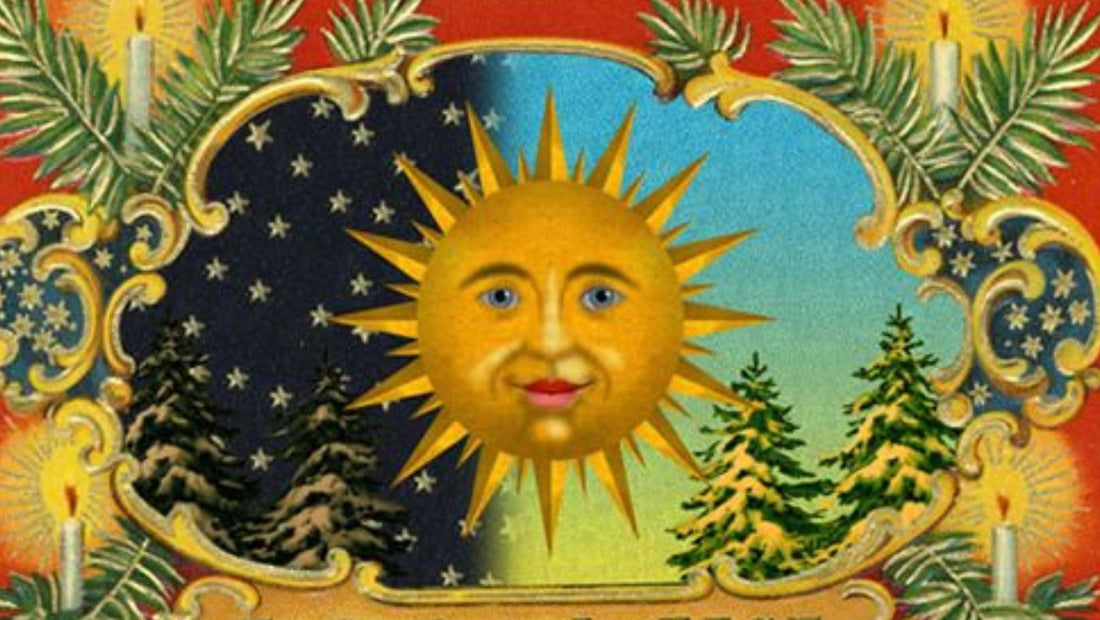
Unwrapping History: A Tapestry of Gift-Giving and Winter Solstice Celebrations
SHOO-FOO TeamShare
In the heart of winter's chill, as frost adorned the world in a crystalline cloak, ancient civilizations sought solace in the promise of light's return. A celestial dance between Earth and cosmos laid the foundation for traditions echoing through time—the giving of gifts and the celebration of the Winter Solstice.
Let us embark on a journey through the annals of history, where cultures embraced the magic of the season, weaving tales of warmth, community, and cosmic wonders.
The Roman Revelry: Saturnalia's Grand Feast

Picture ancient Rome, a city alive with laughter and merriment, as the Festival of Saturnalia unfolded. A time of social upheaval, where masters served their servants and the boundaries of class dissolved in the warmth of camaraderie. The air buzzed with the exchange of small tokens—a precursor to the gift-giving spectacle that marks our modern holiday season. The Romans knew the art of revelry, a celebration where the mundane bowed to the extraordinary.
Saturnalia was an ancient Roman festival that took place in late December, usually around the 17th of the month, and lasted for several days. The festival was dedicated to Saturn, the god of agriculture, and it was one of the most popular and widely celebrated events in the Roman calendar. The exact origins of Saturnalia are not entirely clear, but it likely had agricultural and social significance.
Here are some key aspects of the Festival of Saturnalia:
- Social Reversals: During Saturnalia, social norms were temporarily overturned. Slaves were granted a degree of freedom, and social hierarchies relaxed, fostering an atmosphere of equality and merriment.
- Feasting and Merriment: A time of abundant feasting, drinking, and festivity, Saturnalia provided respite from social constraints, allowing for a more relaxed and joyous atmosphere.
- Gift-Giving: Exchanging gifts was common during Saturnalia, a gesture of goodwill that laid the foundation for modern holiday gift-giving traditions. Pottery or wax figurines were the most common gifts at that time.
- Public Celebrations: Temples were decorated, and processions and ceremonies, including the Sigillaria gift-giving ceremony, filled the streets with festive spirit.
- Candles and Decorations: Homes adorned with candles and greenery symbolized light triumphing over darkness, bringing good fortune.
- Gambling and Games: Saturnalia included various forms of entertainment, including gambling and games of chance, adding to the festive atmosphere.
Saturnalia was a time of joy, generosity, and the celebration of life's abundance. While its religious significance diminished over time, some of its traditions and themes influenced modern Christmas celebrations.
Celtic Whispers: Yule Fires and Mystic Greens

Yule has ancient roots in pre-Christian Germanic and Norse traditions, possibly dating back to the 4th century CE or earlier. It was later absorbed into Christmas celebrations when Christianity spread through those regions.
Here are some aspects of the Yule Traditions and Symbols:
- Evergreen: Symbol of rebirth and renewal, evergreen was believed to have power over death and encouraged the return of the sun as their green never faded. During winter, evergreen was cut and brought inside homes for their smell and their magical power.
- Holly Tree: Branches of the holly tree were used to decorate doors, fireplaces, and windows, as it was believed to ward off evil spirits before they entered their homes. It also represented the masculine element, with the leaves symbolizing hope and the red berries' potency.
- Mistletoe: The green leaves were believed to represent the fertility of the Mother Goddess, and the white berries were the seed of the God of the Forest. The branches were hung on doors as protection against evil and used as a fertility amulet at the head of the bed.
- Yule Tree (or decorated tree) The Yule tree represents the tree of life. Usually an evergreen conifer species, such as pine, fir, cedar, juniper, or spruce they were decorated with natural ornaments (berries, pinecones, and fruits), sacred symbols for the gods. Probably one of the ancient origins of the Christmas tree.
Chinese Dongzhi Festival: Embracing Yin and Yang

Although not directly tied to the Winter Solstice in the Western calendar, the Dongzhi Festival in China is a celebration of the winter solstice. Families gather to enjoy special foods and mark the occasion, symbolizing the increase of positive energy and the defeat of negative forces.
The Dongzhi Festival is deeply influenced by the Chinese philosophy of Yin and Yang, representing the balance of opposing forces. Dongzhi symbolizes the victory of Yang (light and warmth) over Yin (darkness and cold), as the days gradually begin to lengthen after the Winter Solstice.
Depending on the region, various cultural and recreational activities are organized during Dongzhi. These may include dragon and lion dances, lantern displays, and other festivities. Dongzhi has agricultural significance, marking the end of the harvest season and the beginning of winter. It is a time to rest and rejuvenate before the arrival of the spring season.
The Dongzhi Festival embodies the Chinese cultural emphasis on harmony with nature, family unity, and the cyclical nature of life. It's a celebration of the changing seasons and a time to appreciate the warmth and light that family and community bring, especially during the darkest days of winter.
Incan Radiance: Inti Raymi's Solar Embrace

Shift your gaze to the heights of the Andes, where the Inca Empire paid homage to the sun god Inti during the Festival of Inti Raymi. As the Winter Solstice unfolded, the Incas danced and prayed, their rituals intertwined with cosmic rhythms. A celebration of life, fertility, and the sun's return, Inti Raymi wove a tapestry of spiritual reverence that resonates even today.
The Inca Empire existed from the early 15th century until the Spanish conquest in the 16th century. Inti Raymi likely has origins that stretch back to the establishment of the Inca civilization and its reverence for the sun god, Inti.
Here are some aspects of how the Inca Empire likely celebrated the Winter Solstice:
- Festival of Inti Raymi: A major celebration associated with the Winter Solstice, honoring Inti, the sun god. The sun's return symbolized the renewal of life and fertility.
- Ceremonial Rituals: Elaborate rituals performed by Inca priests and nobility, including offerings, prayers, and dances dedicated to Inti.
- Solar Observatories: Skilled astronomers, the Inca had observatories, such as the one at Machu Picchu, determining the timing of agricultural activities and religious ceremonies.
- Feasting and Community Gatherings: Communal feasting and gatherings fostering a sense of community and solidarity.
As for contemporary celebrations, the Inca civilization no longer exists, and the Inca people were assimilated into broader cultural groups after the Spanish conquest. However, some indigenous communities in the Andean region, where descendants of the Inca live, continue to celebrate traditional festivals and rituals.
The Christian Tradition: A Tale of St. Nicholas and Generosity

- Christianity and St. Nicholas: The Christian tradition of Christmas is linked to the celebration of the birth of Jesus Christ. The idea of gift-giving is often associated with the story of the Three Wise Men bringing gifts to the newborn Jesus. Additionally, the figure of St. Nicholas, a Christian saint known for his generosity, became associated with gift-giving in many European cultures. Over time, the name "Santa Claus" evolved from the Dutch nickname for St. Nicholas, "Sinterklaas."
- Medieval and Renaissance Europe: In medieval and Renaissance Europe, the tradition of giving and receiving gifts during the Christmas season became more widespread. Nobility and royalty exchanged elaborate and often expensive gifts, setting a precedent for the practice of gift-giving during the holidays.
- Reformation and Puritanism: During the Protestant Reformation, some groups within Christianity, such as the Puritans, rejected the celebration of Christmas and associated traditions, including gift-giving. However, these practices persisted in many other cultures and denominations.
- 19th Century and Victorian Influence: The 19th century saw a revival of interest in Christmas traditions, thanks in part to writers like Charles Dickens and the publication of "A Christmas Carol." The Victorian era popularized the idea of the Christmas tree adorned with decorations and surrounded by wrapped gifts.
- Commercialization and Modern Christmas: In the 20th century, the commercialization of Christmas further popularized the exchange of gifts. Marketing campaigns and the influence of popular culture, including movies and advertisements, reinforced the association of gift-giving with the holiday season.
Native Echoes: Songs of the Winter Solstice
Across the vast expanse of North America, Native American tribes embraced the Winter Solstice in myriad ways. From the rhythmic dances of the Hopi tribe to the reflective ceremonies of the Cherokee Nation, each community wove its unique story into the fabric of this celestial event. The beating heart of these traditions echoed the rhythms of nature, inviting unity and gratitude.
The specific dates for Winter Solstice celebrations varied among Native American tribes, as their calendars and traditions were diverse. Many tribes held ceremonies and rituals around the time of the Winter Solstice, emphasizing the return of light and the changing of seasons.
Native American tribes have diverse histories and cultures, with Winter Solstice celebrations likely tracing back for centuries. The specific origins would vary among tribes, and the practices were deeply intertwined with their unique cosmologies and traditions.
Modern Echoes: Unwrapping the Gift of Time

Over the centuries, the tradition of gifts giving has been perfectly integrated into our lives. Echoes of Saturnalia, Yule, Inti Raymi and Native American celebrations resonate in the exchange of Christmas gifts, the glow of candles, the revelry and the embrace of loved ones. The winter solstice, once marked by cosmic awe, now intertwines with our contemporary festivities, inspiring us to contemplate the enduring spirit of hope and renewal.
The story continues, a common thread emerges: the celebration of the lengthening days. Across cultures and continents, the winter solstice, marking the shortest day and longest night, acts as a canvas on which cultures paint their stories of hope, renewal and the triumph of light on the darkness. It is good to remember this.
If you are on the mood for Gifts Giving, visit our Monthly Offers section to see if you can find the precious gift that will put sparks in their eyes ✨Happy Holidays✨

